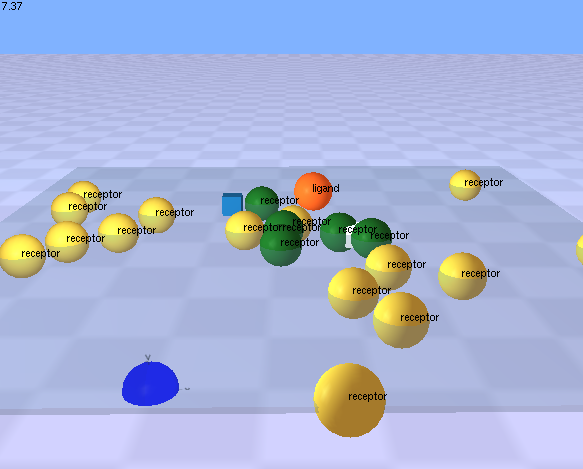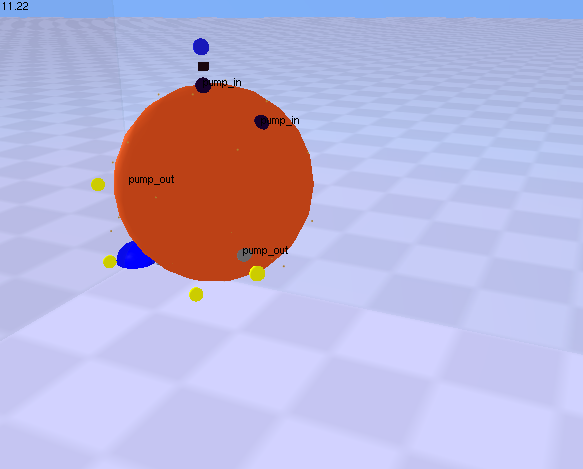Difference between revisions of "Magrathea"
| Line 14: | Line 14: | ||
default [[Special:Player/rules.1.mpeg]] | default [[Special:Player/rules.1.mpeg]] | ||
</imagemap> | </imagemap> | ||
| − | || | + | || This is a simple demonstration of the use of rules by coordinators. |
| − | + | This example shows a substrate (molecule 1) that undergoes a state-change (phosphorylation) upon interaction with a kinase (molecule 2). The state change is visualized by a colour change. | |
|- | |- | ||
|<imagemap> | |<imagemap> | ||
| Line 21: | Line 21: | ||
default [[Special:Player/rules.2.mpeg]] | default [[Special:Player/rules.2.mpeg]] | ||
</imagemap> | </imagemap> | ||
| − | || | + | || This demonstration shows a somewhat more complex use of rules to demonstrate the process of lateral signalling. |
| + | In this example, a ligand molecule binds to a membrane-bound receptor. On binding, the receptor changes state (becomes activated) as indicated by a colour change. The receptor in this new state also gains the ability to bind to and activate other membrane bound receptors. The overall effect is that a single ligand-receptor binding event initiates a lateral cascade of receptor activation events. | ||
|- | |- | ||
|<imagemap> | |<imagemap> | ||
| Line 27: | Line 28: | ||
default [[Special:Player/Rules.3.mpeg]] | default [[Special:Player/Rules.3.mpeg]] | ||
</imagemap> | </imagemap> | ||
| − | || | + | || This demonstration shows a set of rules that control translocation into and out of a spherical compartment. A number of ligand molecules (blue) bind to a surface receptor (black) on the orange compartment’s surface. The coordinator handling this ligand receptor interaction encodes a rule that translocates the ligand into the orange compartment and changes the state of the ligand such that it is capable of binding to a second receptor (grey) that is also a surface component of the orange compartment. This state change is associated with a colour change for the ligand molecule (blue to yellow). A second coordinator handles the interaction between the ligand and the second receptor and encodes a rule that translocates the ligand out of the orange compartment. Once the ligand is outside the compartment, its state (yellow) prevents it from assembling with the importing receptor (black) for a second time. |
|- | |- | ||
| bgcolor="steelblue" colspan="2" align="center"| | | bgcolor="steelblue" colspan="2" align="center"| | ||
Revision as of 15:03, 27 September 2008
Magrathea a prototype application that demonstrates the use of coordinated agent modeling.
Click here to go to the Donaldson page on the BiO web site. Click here to go to an internal link on the iRefIndex project.
Here are some sample movies from the Magrathe project.
| This is a simple demonstration of the use of rules by coordinators.
This example shows a substrate (molecule 1) that undergoes a state-change (phosphorylation) upon interaction with a kinase (molecule 2). The state change is visualized by a colour change. | |
| This demonstration shows a somewhat more complex use of rules to demonstrate the process of lateral signalling.
In this example, a ligand molecule binds to a membrane-bound receptor. On binding, the receptor changes state (becomes activated) as indicated by a colour change. The receptor in this new state also gains the ability to bind to and activate other membrane bound receptors. The overall effect is that a single ligand-receptor binding event initiates a lateral cascade of receptor activation events. | |
| This demonstration shows a set of rules that control translocation into and out of a spherical compartment. A number of ligand molecules (blue) bind to a surface receptor (black) on the orange compartment’s surface. The coordinator handling this ligand receptor interaction encodes a rule that translocates the ligand into the orange compartment and changes the state of the ligand such that it is capable of binding to a second receptor (grey) that is also a surface component of the orange compartment. This state change is associated with a colour change for the ligand molecule (blue to yellow). A second coordinator handles the interaction between the ligand and the second receptor and encodes a rule that translocates the ligand out of the orange compartment. Once the ligand is outside the compartment, its state (yellow) prevents it from assembling with the importing receptor (black) for a second time. | |



